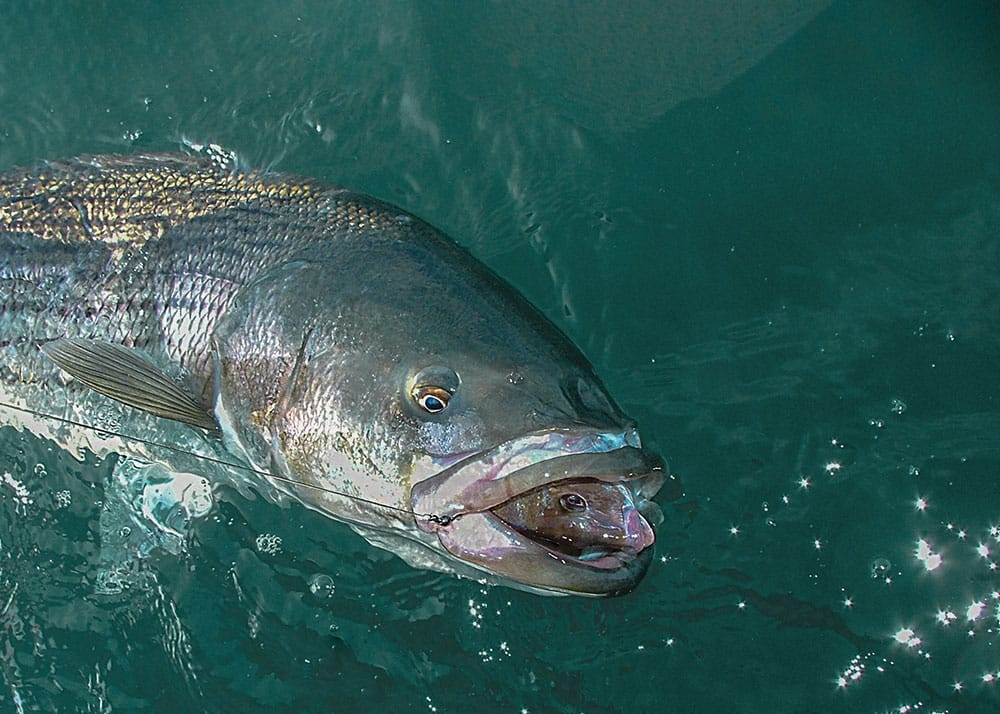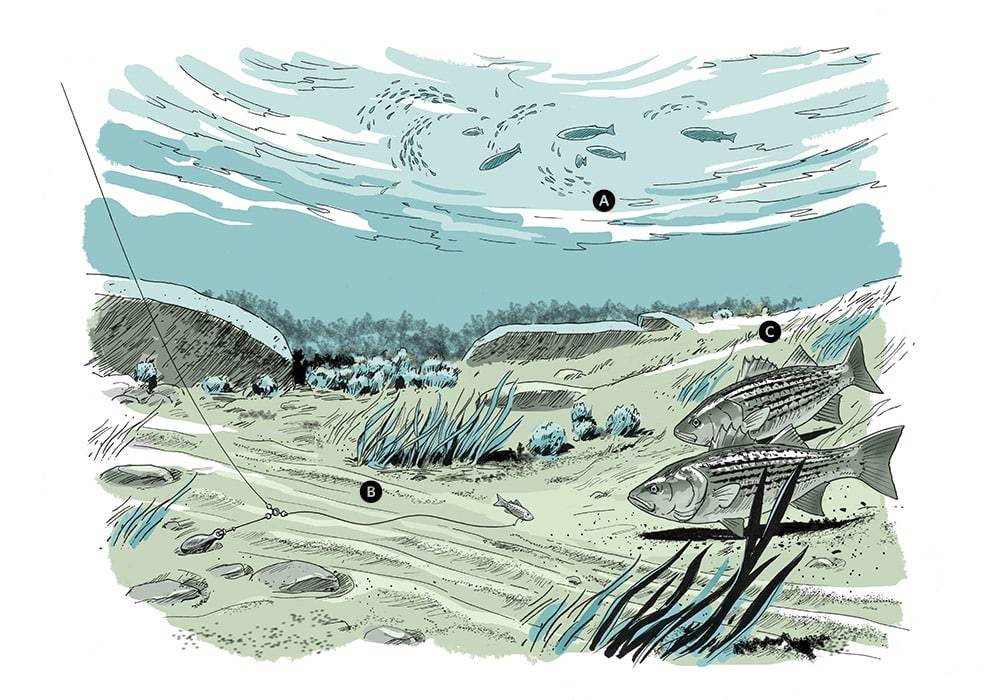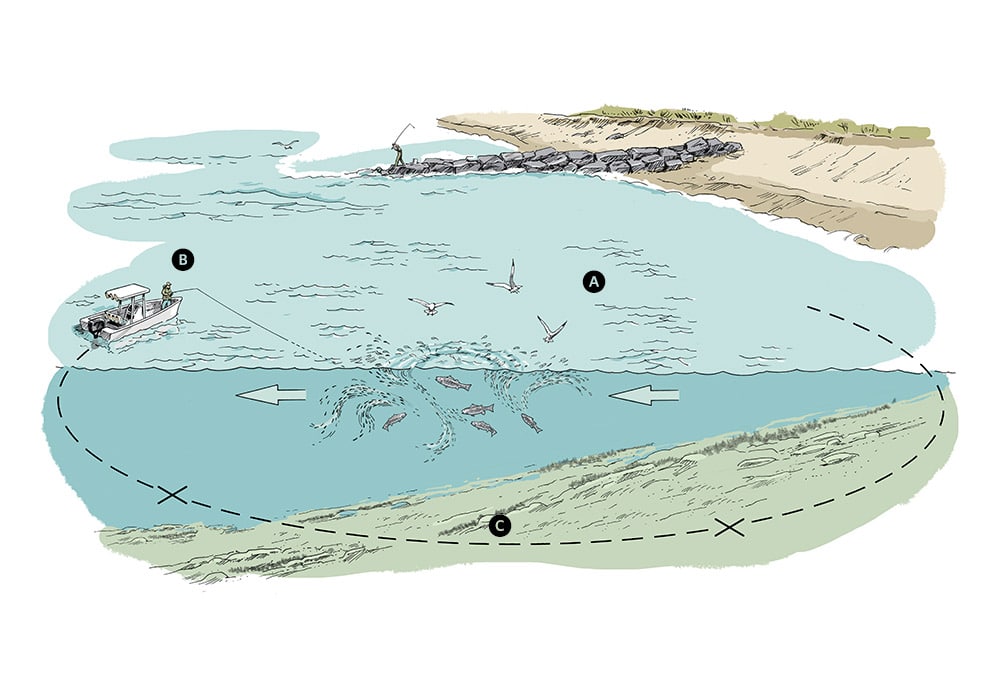
Capt. Steve Purul loves putting clients onto Barnegat Bay trophy bass. A couple of years back, he led me to a few bunker schools migrating down the beaches, where he had me swim out a live bunker upon our arrival. Within minutes, I played out — and released — a beautiful trophy striped bass on spin tackle.
As basic as it appears, live-lining for trophy bass among bunker schools has its nuances. And subtleties are what separate the pros, like Purul, from the novices when it comes to logging trophy stripers over the course of a season.
Here are five of Purul’s top tips to catch more and bigger trophy striped bass around bunker schools.

Read the Schools
Regardless of how abundant bait schools may be, identify one that is unlike the rest. “Look for the unhappy school,” Purul says. “Obviously, if bass are blowing up in them, that’s one thing, but when things appear calm, look for interruptions in the school’s rhythm. This could be what we call ‘pulsing,’ where parts of the school open and close back up, or if that school changes shape or suddenly changes direction. This usually means they’re under duress from bass stalking them from the depths. Learn to recognize the smallest hints when things are calm, and you’ll be in a much better position to score a trophy.”
Purul also looks beyond the surface, consulting his fish finder for stripers or disturbed schools of bait that haven’t pushed to the surface. “This is not for the novice,” Purul claims. “A uniform cloud of bait is one that is undisturbed. But baits that appear fragmented indicate foraging bass. I’ve scored many times in this instance by lowering a treble hook to depths approaching 60 feet, snagging a bunker, and keeping it down there. It takes practice and patience, but the results are often worth it.”
Sensible Approaches
Success is often not a matter of arriving first to a bait school, but rather making a sensible approach. “Don’t drive into a school,” Purul says. “Keep your distance, note the direction the school is moving, and then position yourself ahead of it; let them come to you. I’ll stop a long cast ahead of a school so I won’t disturb them. Plus, I’ll have plenty of time to cast and snag baits, as well as set out deep ones. When the school passes, I’ll make a wide circle around them and reset in their path, providing that school is holding bass or appears promising.”
Avoid the Net
For the same reason as avoiding driving into a bunker school, Purul opts to snag his bunker, versus cast-netting. “Throwing a net could upset the dynamics of the school and any bass stalking them; plus, it’s a process, readying, throwing and culling baits from the net,” Purul says. “By snagging baits, you’re instantly fishing, or will be within minutes if you’d rather reel them in and pitch them back out on circle hooks.”

Subtle Positioning
After snagging baits, often on 1- and 1½-ounce trebles, Purul lets them swim freely, with just enough tension on the line to sense their activity. Covering the bases, Purul pins at least one bait to the bottom on a three-way-swivel rig comprised of a 10/0 Octopus-style hook on 30-pound fluoro leader and a 10- or 12-ounce sinker. “I’m not a fan of a sliding sinker rig in this situation,” Purul says. “A bunker can swim up and away from the bottom on one, as there’s no direct weight to hold it down. It can’t swim that weight up for long on a three-way rig; it’ll keep them on or very close to bottom, for those deep holding bass.” With multiple anglers, it’s important to stagger the baits to prevent fouled lines; one angler lets out a bait, followed by the second angler at a distance.
Patience and Change Up
If a school looks promising, stick with it, Purul advises. But when the chips are down and the traditional isn’t working, it’s time for a change. In Purul’s case, the live bait on the three-way bottom rig is swapped out for a freshly severed bunker (cut in a sickle shape in front of the vent, to mimic a bluefish strike). “Sometimes trophy bass key on bunker remnants from bluefish blitzes,” Purul says. “Don’t neglect giving that strategy a try before you leave a school. If they’re in such a selective feeding mood, they’ll ignore a live bait but race off with that chunk. It happens nine out of 10 times.”









